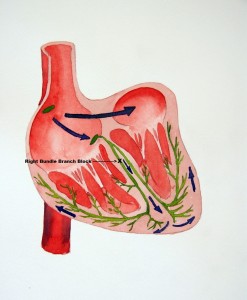Bundle Branch Block
A Bundle Branch Block is basically a blockage at the AV Bundle of HIS, which slows down the conduction of the electrical impulses through the bundle branches. A Bundle Branch Block is identified whenever a QRS complex is greater than 0.10 seconds in duration.
When looking at a Bundle Branch Block on an ECG you look at leads: I, V1 and V6. A Bundle Branch Block is diagnosed when the QRS complex exceeds 0.10 seconds in duration (which identifies a conduction delay through the ventricles).
Here is an image of a Bundle Branch Block in a heart:
In this example, you can see the blockage in the Right Bundle Branch, causing a blockage down the Bundle Branches and subsequent conduction delays.
How to Determine Bundle Branch Block Side
If you want to determine whether or not a bundle branch block is to the left or right this is how you do so:
In V1 the QRS complex is primarily pointed upwards and this is determined to be a right sided Bundle Branch Block.
In V1 the QRS complex is primarily pointed downwards, then this is determined to be a left sided Bundle Branch Block.

